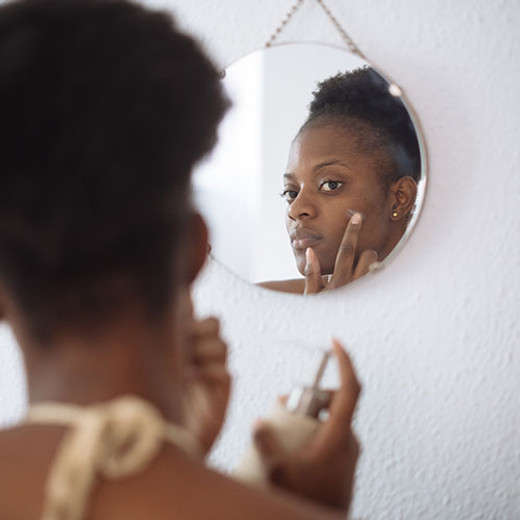What Is A BHA Exfoliant and Why Do I Need It?
Posted by Ellie Swain on Nov 30th 2020
BHA exfoliant is a beauty buzzword you may have already heard. But what exactly does a BHA exfoliant do, and why should you buy one for your bathroom shelf?
Daily exfoliation is an easy and effective way to achieve the smooth, clear, and hydrated skin we all strive for, and using a leave-on BHA exfoliant is one of the best ways to reach such goals.
Leave-on exfoliants like BHAs gently but quickly eliminate dead skin cells, revealing softer and younger-looking skin. Many BHA exfoliants also help to combat blemishes, blackheads, and enlarged pores. Some can boost hydration and tackle the effects of skin aging.
With so many high-quality BHA exfoliants to choose from on the market, you’re sure to find a bottle that works wonders for your skin type.
Sounds pretty great, huh? Let’s learn more about BHA exfoliants, including who they’re best suited for and how to use them.
What Is a BHA Exfoliant?
BHA is an abbreviation for beta hydroxy acid. BHA is otherwise known as salicylic acid, another recognized ingredient that’s hitting the skincare limelight.
While the word ‘acid’ may sound aggressive, don’t let it put you off. BHA isn’t corrosive, abrasive, or destructive at all. In fact, BHA contains soothing properties and is gentler on your skin than many popular scrubs and hard cleansing brushes.
What Is a AHA Exfoliant?
AHAs often come hand-in-hand with BHAs. AHA stands for alpha hydroxy acids and includes glycolic and lactic acids.
Both AHAs and BHAs ‘unglue’ the bonds fixing dull and dead skin cells to the surface. Once the acids gently and evenly break the bonds, the skin naturally sheds these dead cells, uncovering smooth and glowing skin.
You won’t actually see your skin shedding, but you’ll soon notice the difference when softer and younger-looking skin is revealed.
AHA and BHAs reduce fine lines and wrinkles' appearance and make the skin look and feel firmer and plumper.
However, while AHA and BHAs have their similarities, they also have unique properties, making each suitable for specific skin types and concerns.
AHAs are water-soluble, so they are only effective on the skin’s surface. They’re generally chosen for people with normal, dry, or sun-damaged skin. That’s because they’re renowned for enhancing the skin’s natural moisture, providing plenty of much-needed hydration. While BHAs are also hydrating, they feed the skin in a different way than AHAs.
AHAs are also excellent for reducing the visible signs of sun-damaged skin, including that crepe-like skin texture the complexion can develop after too many hours spent under the hot sun.
Unlike AHAs, BHAs work on the skin’s surface and deep inside the pore.
For the best of both world’s try Neova’s Intensive Retinol Spray. The concentrated leave-on exfoliant is packed full of AHA, BHA, and retinol to improve the appearance of skin texture, firmness, and elasticity.
Who Is a BHA Suitable For?
Many people may question whether they should use a BHA or AHA exfoliant, or both. While many people opt for a formula containing both, using just one is fine too.
BHA is ideal if you suffer from clogged pores and bumps on the face and body, as its oil-soluble, allowing it to clean deep within the pores. After a few uses, you’re likely to experience fewer lumps and bumps and less visible pores.
A BHA is also excellent for those suffering from keratosis pilaris. This is a harmless yet common skin condition that results in dry, rough patches and small bumps.
BHAs also contain natural skin-calming properties, so people with sensitive skin or those who are susceptible to redness or rosacea can breathe a sigh of relief. Think of BHAs as a well-rounded, soothing, and gentle ingredient that everyone can use.
How Do You Use a BHA Exfoliant?
A BHA exfoliant (and an AHA, for that matter) should always be used after cleansing and toning. Any other products in your routine, like a serum or day or night cream, should be applied after your BHA. As a rule of thumb, always start from the thinnest to the thickest texture.
To finish off your skincare routine, we suggest using Revision’s deep restorative night cream. The lightweight formula rejuvenates the skin as you snooze, reducing the appearance of fine lines and wrinkles. Talk about multi-tasking.
Fortunately, you don’t need to sit there, tapping your fingers, waiting until your skin has absorbed all the different products in your routine. The BHA will still work its magic if you apply other formulas immediately before or after.
Daily exfoliation works best for many people, but if your skin is sensitive, you may try exfoliating every other day or so. Don’t be afraid to experiment so you can get it right.
Want more skin advice? Learn what double cleansing is and why you should practice it.

